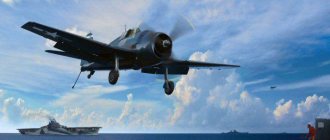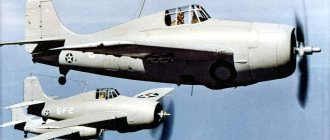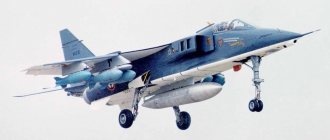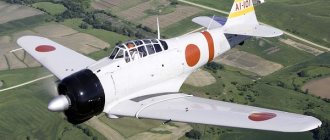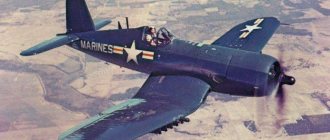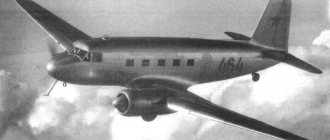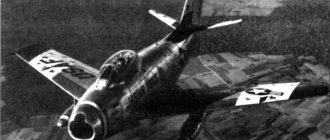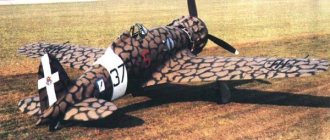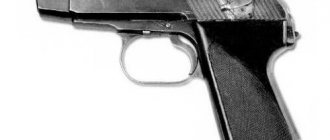Carrier-based fighter F-8 Crusader, its predecessors and descendants (Part 1)
In the 50s of the last century, many interesting examples of aviation technology were created in the United States, which left a noticeable mark on the history of world aviation.
One of these aircraft was the F-8 Crusader carrier-based jet fighter (Russian: Crusader), created by Vought. The creation and adoption of the Crusader was preceded by an epic, during which American admirals in the 50s went through several types of carrier-based fighters, many of which did not serve even 10 years. In the first post-war decades, military aviation developed at a very rapid pace, and jet fighters adopted for service often became obsolete even before the mass entry into the army began. During the Korean War, the US Navy needed a naval fighter capable of standing on equal terms with the Soviet MiG-15. As an emergency measure, North American created a carrier-based version of the Saber fighter, the FJ2 Fury. It differed from the F-86E Saber (Russian Saber) in having a folding wing, a device for landing using a cable arrester, a mount for launching from a catapult, and a more robust design, which was caused by large overloads during takeoff and landing on the deck. Instead of six heavy machine guns, as on the early versions of the Saber, the naval model was immediately equipped with four 20-mm cannons. Compared to the F-86F intended for the Air Force, the “dry” weight of the deck version was almost 200 kg more. The FJ-2 fighter with a maximum take-off weight of 8520 kg was equipped with a 1 × General Electric J47-GE-2 turbojet engine with a thrust of 26.7 kN. Maximum speed at low altitude is 1080 km/h. Combat radius is about 500 km.
FJ3 Fury carrier-based fighter
The carrier-based Sabers did not make it to the Korean War; representatives of the Navy accepted the first fighters only in January 1954. In 1955, improved FJ3s appeared on the decks of American aircraft carriers, differing from the FJ2 with a 32.2 kN Wright J65 engine (a licensed version of the British Armstrong Siddeley Sapphire). Although more than 700 fighters were delivered to the fleet and they were equipped with AIM-9 Sidewinder guided missiles, by the mid-50s the Furies were no longer fully suitable for the role of carrier-based interceptors and the aircraft were reclassified as fighter-bombers. The operation of the aircraft was complicated by the unreliable operation of the engines at conditions close to the limit. Due to the destruction of the engines, several FJ3s crashed in flight. In connection with this, restrictions were introduced on the maximum permissible engine speed and the FJ3 actually had no advantages over the earlier modification.
The Fury became the first combat aircraft to be lost in combat in Southeast Asia. In 1962, two squadrons from the aircraft carrier USS Lexington (CV-16) attacked targets in Laos. Hit by anti-aircraft fire, the fighter-bomber hit the deck upon landing and caught fire. Although the plane could not be restored, the pilot remained alive. Deck-based Furies, except for the coloring adopted by the Navy, were practically no different from Sabers, but many times fewer of them were built. The US Navy and Marine Corps received 740 aircraft. Their service with carrier wings continued until 1962. But for several more years the aircraft were actively used at coastal airfields.
A flight of carrier-based FJ4 fighters from squadron VA-63 in 1958
Simultaneously with FJ3, the Navy and ILC received FJ4. This modification featured a thinner wing profile and increased fuel capacity. The maximum take-off weight increased to 10,750 kg, and the flight range with a PTB and two Sidewinder missiles reached 3,200 km. The armament remained the same as on the early Fury models, and the maximum speed at altitude reached 1090 km/h. Just like previous carrier-based Saber models, the FJ4 began its service as a fighter-interceptor, but was later repurposed for attack missions. A total of 374 FJ4 aircraft were delivered to the fleet. Their operation in Marine Corps aviation continued until the end of the 60s.
To counter the Soviet jet torpedo bombers Tu-14 and Il-28, which were supplied in significant numbers to the aviation regiments of the USSR Navy, the Americans needed faster carrier-based fighters. In connection with this, the F9F Cougar became the main carrier-based interceptor in the second half of the 50s and was created on the basis of the F9F Panther carrier-based jet fighter. The main difference from the Panther was the swept wing. The fleet command classified the Cougar as a new model of the Panther and therefore the aircraft had the same alphanumeric index.
F9F Cougar carrier-based fighter
The carrier-based fighter with a maximum take-off weight of 9520 kg was accelerated by a Pratt & Whitney J48-P-8A turbojet engine with a thrust of 38 kN to 1135 km/h. Practical flight range – 1500 km. To replenish the fuel supply in the air, the plane had a refueling probe. Although the Cougar's maximum flight speed was not much higher than that of the Fury, the modernized carrier-based Cougars had a longer flight range, were equipped with an APG-30A radar, an Aero 5D fire control system and air-to-air missiles. Built-in armament included four 20 mm cannons.
The first squadron of VF-24 Cougars was deployed to the aircraft carrier USS Yorktown (CV-10) in August 1953, but did not see combat in Korea. In 1958, carrier-based fighter pilots switched to more modern aircraft, but the Cougars continued to be used in reconnaissance and training squadrons. The two-seat training version of the F9F-8T was used by the USMC as a reconnaissance and guidance aircraft during the initial period of the Vietnam War. In total, about 1,900 single and two-seat Cougars were built, the last two-seat aircraft being retired in 1974.
It was assumed that the F9F Cougar fighter in American carrier-based fighter squadrons would be replaced by the supersonic F11F Tiger. This aircraft was designed by Grumman specialists taking into account the “area rule”. The fighter, which first took to the air in 1954, had good flight characteristics. The aircraft with a maximum take-off weight of 10,660 kg was equipped with a Wright J65-W-18 engine with an afterburner thrust of 47.6 kN and could accelerate in horizontal flight to 1,210 km/h. The combat radius with two AIM-9 Sidewinder missiles and two external fuel tanks was 480 km. There was no radar on the Tiger; targeting had to be carried out according to commands from a ship's radar or a carrier-based AWACS aircraft. The armament of the serial fighters consisted of four 20-mm cannons, located in pairs under the air intakes, and four AIM-9 Sidewinder missiles with an infrared homing head.
F11F Tiger carrier-based fighter
The Tigers began entering combat squadrons in 1956. From the very beginning, the fighter proved itself positively and was popular with the flight and technical personnel. Pilots valued it for its excellent maneuverability and good controllability at low speeds, which was especially important when landing on the deck of an aircraft carrier. Among technicians, the Tiger has earned a reputation as a simple, easy-to-maintain, and almost accident-free aircraft.
However, for all its advantages, the F11F did not satisfy the admirals as a carrier-based interceptor. The Tiger, due to its maneuverability, was almost ideally suited for the role of an air superiority fighter, but in the late 50s information appeared about the creation of the Tu-16 long-range jet bomber-missile carrier in the USSR. The American Navy needed a radar-equipped fighter with a long range and flight speed. Serial production of the Tigers ceased in 1959; in total, about 180 F11Fs entered carrier-based squadrons. Already in 1961, the aircraft were withdrawn from the first line units, and in 1969 they were finally retired.
Along with the relatively light Fury, Cougar and Tiger, American admirals considered it advisable to have a heavy carrier-based interceptor equipped with a powerful radar and capable of operating autonomously at a considerable distance from an aircraft carrier. The McDonnell company began creating such an aircraft in 1949, and in 1951 the first flight of the prototype took place. The aircraft seemed very promising, and the Navy placed an order for 528 carrier-based interceptors. However, the tests were very difficult; due to the unreliable operation of the Westinghouse XJ40 engine and failures in the control system, 12 prototype aircraft were crashed during test flights, after which the order was reduced to 250 aircraft.
The first production modification, which entered service in March 1956, received the designation F3H-1N Demon. The all-weather deck-based “Demon” was equipped with a Westinghouse J40-WE-22 turbojet engine with an afterburner thrust of 48 kN. The cars of the first modification were not popular due to their too capricious engines, and only 58 copies were built. The F3H-2N, built in the amount of 239 units, became more widespread. This model was equipped with a more powerful Allison J71 - A2 engine, which produced 63.4 kN in afterburner mode. But simultaneously with the increase in power, fuel consumption increased, and in order to maintain the same flight range it was necessary to increase the volume of fuel tanks, which in turn led to an increase in the maximum take-off weight. The pilots really did not like to take off with tanks filled under the plugs and with a maximum combat load. The Demon's thrust-to-weight ratio was low and the slightest sneeze from the single engine on takeoff could lead to disaster.
The F3H-1N Demon carrier-based interceptor and the FJ3 Fury carrier-based fighter-bomber fly together in 1958.
A significant difference in the size of the aircraft is noticeable. The Demon turned out to be the heaviest American carrier-based fighter of the mid-50s. The maximum take-off weight of the F3H-2N modification was 15,380 kg, that is, almost twice as much as that of the Fury. The single-seat F3H-2N interceptor accelerated to 1,152 km/h at high altitude and had a combat radius of 920 km.
The aircraft carried an AN/APG-51В/С radar, which was very advanced for its time, with a detection range of up to 40 km. Prior to this, an early model of the AN/APG-51A radar was tested on the F2H-4 Banshee carrier-based interceptor. Thanks to the presence on board of this Demon station, the F3H-2M modification became the first naval fighter capable of using the AIM-7 Sparrow missile with a semi-active radar homing head. The four external nodes could also carry AIM-9 Sidewinder missiles and 70-mm Mk 4 FFAR missiles. Built-in armament included four 20 mm cannons located under the cockpit in a kind of chin. After the introduction of long-range missiles into the armament, two guns were dismantled to reduce the weight of the aircraft. After the Demons gained the ability to carry long-range missiles, the order for them was increased. In total, the US Navy received 519 F3H interceptors of all modifications.
F3H-2M interceptor with AIM-7 Sparrow missiles
The appearance of the “Demon” shows the features of the famous F-4 Phantom II, which appeared as a result of the development of the Super Demon project. Although the Demon played one of the main roles in providing air defense to aircraft carrier formations in the mid-50s, like its other peers, it quickly left the scene in the early 60s. After the supersonic Crusaders and Phantoms were adopted, by 1964 they had completely replaced all Demons.
For the role of a loitering carrier-based interceptor in the second half of the 50s, the US Navy and Marine Corps considered the F4D Skyray (Russian: Sky Ray) from the Douglas company; this aircraft was a kind of insurance in case the Demon interceptor could not be brought to condition. The F4D fighter lived up to its name and was built according to the flying wing design. In the serial modification, the aircraft was equipped with a Pratt Whitney J57-P-2 turbojet engine with an afterburner thrust of 64.5 kN. The carrier-based interceptor with a maximum take-off weight of 10,200 kg had a combat radius of just over 350 km and could reach speeds of up to 1,200 km/h at high altitude. When flying without afterburner, at a speed of 780 km/h, the combat radius could exceed 500 km. The armament was the same as on other carrier-based fighters - four 20-mm cannons and an AIM-9 missile launcher. However, at the time of development, the main weapon of the F4D was considered to be 70 mm unguided air-to-air missiles Mk 4 FFAR, better known as the Mighty Mouse (Russian: Mighty Mouse - the hero of comic books and animated films). American strategists, impressed by the German experience in using unguided missiles, believed that a massive NAR salvo would destroy the bomber without entering the range of its defensive artillery installations. The destructive effect of a single 70mm rocket hit was comparable to that of a 75mm fragmentation shell. At a distance of 700 m, about a third of the salvo of 42 NARs hit a target measuring 3x15 m. In total, up to 76 unguided missiles in four blocks could be on board the interceptor. The APQ-50A airborne radar could detect bombers at a range of up to 25 km. The avionics included an Aero 13F fire control system, interfaced via a radio relay link with the ship's combat control system.
F4D Skyray carrier-based interceptor
The production copy of the "sky stingray" took off in July 1954, and in the spring of 1956, the first combat squadron of VF-74 was relocated to the aircraft carrier USS Franklin D. Roosevelt (CV-42). For its time, the “Sky Stingray” was a good interceptor and had a good rate of climb (90 m/s), but in close air combat it was hopelessly inferior to other American carrier-based fighters. Serial production of the F4D Skyray continued until 1958; in total, the fleet and marine aviation received 422 aircraft. The Sky Ray was in active service not much longer than the Tiger. In 1964, all carrier-based interceptors were written off ashore, and for several more years they provided air defense to naval bases.
In the mid-to-late 50s, the American Navy Air Force simultaneously had five different types of carrier-based fighters in service, among which there were also very different modifications. This, of course, complicated the logistics of spare parts supply and operation, and required separate training for pilots and technical personnel. Having analyzed the state of affairs, the Navy command came to the conclusion that it was necessary to reduce the number of types of new generation fighters being accepted into service. This was partly achieved, but at the same time, in the 60-70s, the variety of American carrier-based attack aircraft increased.
In the early 50s, American military analysts predicted the imminent appearance of anti-ship cruise missiles and supersonic bombers in the USSR. Existing carrier-based fighters, as expected, could not adequately fend off these threats. To effectively intercept such air targets, a supersonic fighter with a flight speed of more than 1.2 M and a combat radius of at least 500 km was required. To independently search for targets, a promising carrier-based fighter would have to have a powerful radar, and the armament would have to include homing air combat missiles.
At the beginning of 1953, the US Navy announced a competition to create a carrier-based fighter-interceptor, which, in addition to fighting high-altitude high-speed targets, was supposed to outperform the Soviet MiG-15 in maneuverable air combat. The four finalists, along with Vought's V-383, included Grumman's XF11F-2, McDonnell's twin-engine F3H-G, and North American's deck-based F-100. In May 1953, following a review of the projects, the V-383 was declared the winner. The project was given the designation F8U-1, and Vought was required to promptly provide a wooden model for wind tunnel testing. Based on the results of blowing the models in the wind tunnel and after a positive conclusion from the mock-up commission, in June 1953 the fleet ordered three prototypes. Already on March 25, 1955, the lead XF8U-1, taking off from Edwards Air Force Base, exceeded the speed of sound on its first flight. Without waiting for the tests to be completed, the admirals placed an order for a production batch of fighters. As a result, the first production F8U-1 flew in September 1955, at the same time as the second XF8U-1 prototype. The aircraft, which received the corporate designation F8U-1 Crusader (Russian Crusader), was tested on the aircraft carrier USS Forrestal (CV-59) in April 1956. On August 21, 1956, the Crusader reached a speed of 1,634 km/h over the China Lake test site in California. In December, new fighters began to enter service with combat squadrons. By the end of 1957, the Crusaders were already in service with 11 carrier-based squadrons of the Navy and Marine Corps.
F8U-1 Crusader carrier-based fighter
When creating the aircraft, a number of technical innovations were implemented. The high-mounted wing with a 42° sweep was equipped with a system for changing the installation angle. During takeoff and landing, the wing angle increased by 7°, which increased the angle of attack, but the fuselage remained in a horizontal position. At the same time, the ailerons and slats located along the entire span of the leading edge of the wing were automatically deflected by 25°. Between the ailerons and the fuselage there were flaps deflected by 30°. After takeoff, the wing lowered and all deflectable surfaces assumed a flight position.
Thanks to the variable installation angle and mechanization of the wing, it was possible to facilitate landing and reduce the load on the landing gear. Landing was also possible with the wing down, and this happened several times. However, this mode was considered dangerous due to worse controllability. The high-mounted wing greatly simplified aircraft maintenance and the work of gunsmiths. The wing tips folded upward to reduce the footprint on the deck and in the aircraft carrier's internal hangar. In accordance with the “rule of areas”, the fuselage was narrowed in the area where it meets the wing. In the forward part of the fuselage there was an oval-shaped frontal air intake, above which there was a radio-transparent fairing of the APG-30 radar. When creating the aircraft, titanium alloys were widely used, which made it possible to increase the weight perfection of the design. Along with advanced technical solutions, the promising carrier-based fighter inherited from its predecessors a battery of 20-mm Colt Mk.12 cannons with 144 rounds of ammunition per barrel and a 70-mm Mk 4 FFAR.
Ventral container with NAR
The ventral container contained 32 70-mm rockets. Although the F8U-1 was intended to be the fastest naval fighter, during the design stage it was envisaged that it would retain the capability of conducting close-in maneuverable air combat. The Crusader was the last American carrier-based fighter to carry guns as its main armament. Due to the fact that the wing changed its angle of inclination during takeoff and landing, additional weapons hardpoints had to be placed on the fuselage.
Soon after entering service, the aircraft began to be equipped with an in-flight refueling system. This made it possible to significantly increase the combat radius and ferry range. A place was found for the fuel receiver under the convex fairing on the left side behind the cockpit canopy. The aircraft of the first series were equipped with a Pratt Whitney J57-P-12A or J57-P-4A engine with an afterburner thrust of 72.06 kN.
In September 1958, the second production modification F8U-1E appeared. The fighter, converted from the F8U-1, featured a new AN/APS-67 radar with a smaller diameter antenna. On this model, the ventral container with NAR was sewn up tightly. Thanks to a more advanced radar, the F8U-1E was able to operate at night and in bad weather. But to bring the aircraft to the target, commands from the operator of a ship’s surveillance radar or an AWACS aircraft were required. In February 1960, the F8U-2N fighter with improved on-board avionics, making it easier to fly at night, was submitted for testing. The main innovation was the automatic landing system, which allows, using the on-board computer, to maintain the landing speed with an accuracy of ±7.5 km/h, regardless of wind speed and direction. Thanks to the introduction of this system, it was possible to significantly reduce the accident rate. The fighters were equipped with new J57-P-20 engines with a nominal thrust of 47.6 kN (with afterburner 80.1 kN). Thanks to this, the maximum flight speed at an altitude of 10,675 m could reach 1,975 km/h. At the ground, the Crusader accelerated to 1226 km/h. An additional fuel tank was installed in place of the useless compartment with NAR, which made it possible to increase the fuel supply to 5,102 liters. The maximum take-off weight reached 15540 kg. Normal, with two AIM-9 missile launchers - 13,645 kg. The combat radius with two air combat missiles is 660 km.
Already in June 1961, tests began on the next modification F8U-2NE with the AN/APQ-94 radar, which could detect a Tu-16 bomber at a range of up to 45 km. To accommodate a larger radar antenna, the dimensions of the radio-transparent radome had to be slightly increased. An infrared sensor appeared above the radar fairing.
F-8E (F8U-2NE) from the USMC Air Force at Da Nang airbase in April 1966.
The IR sensor is clearly visible above the radar radome. After the target was captured by the IR seeker of the AIM-9 Sidewinder missile, the pilot continuously monitored the range to the attack target using the radar. Information about the range was displayed using light indicators and, after reaching the permitted launch distance, was duplicated with a sound signal. In addition, equipment for radio command guidance of the AGM-12 Bullpup air-to-surface missile was placed in the “hump” above the center section. For attacks on ground targets, units with 70-127 mm NAR and bombs weighing 113-907 kg could be used. Typically, the typical load in the shock configuration was four 454-kg bombs and eight 127-mm Zuni rocket launchers on the fuselage assemblies.
Serial “Crusaders” of the “all-weather” and “all-day” modification F8U-2NE began to be mastered by combat pilots at the end of 1961. The following year, the designation system for naval aircraft changed according to the type adopted by the Air Force, within which the F8U-1 received the designation F-8A, F8U-1E - F-8B, F8U-2 - F-8C, F8U-2N - F-8D, F8U-2NE - F-8E. Production of the F-8E modification continued until 1965. Over ten years, 1261 aircraft were built.
F-8 catching fire after landing on an aircraft carrier
At the beginning of its life, the Crusader turned out to be a very dangerous vehicle. Landing on it has always been difficult; compared to the previous generation fighters, the F-8s fought much more often. The F-8 had 50 flight accidents per 100,000 flight hours, while the A-4 Skyhawk had 36. However, after the introduction of an automatic landing speed control system and the accumulation of experience by the flight crew, the accident rate was reduced. However, the Crusader had a reputation for being tough to drive. At the same time, the F-8 stayed quite well on the tail of even the fairly maneuverable FJ3 Fury fighter, which was greatly facilitated by its relatively low stall speed of only 249 km/h. To train pilots, a number of retired F-8As were converted into two-seat TF-8A trainers with redundant controls.
Double TF-8A on the deck of an aircraft carrier
Two guns were removed from the training aircraft. The maximum speed was limited to 1590 km/h. The instructor pilot sat in the rear cockpit, superior to the student.
The Crusader has had some rather unusual episodes at times. In August 1960, due to the inattention of the pilot and flight director, the Crusader took off from the runway of an airbase near Naples with its wings folded. At an altitude of 1.5 km, after switching the engine to nominal operating mode, the pilot discovered that the plane had poor control in the air and responded sluggishly to control commands. However, instead of ejecting, the pilot drained the fuel and landed the fighter safely 20 minutes later. According to American data, there were eight such cases in the F-8 biography.
Another story happened to a young pilot in the late 60s while practicing landing at Lekhurst airbase. Having twice failed to catch the hook on the landing cables, during the third approach he panicked, lost control of the plane and ejected. After this, the unmanned F-8N went down and made a “landing” on its own, hooking its hook onto the cable. The plane received minor damage and was quickly repaired.
When talking about the deck-based Crusader, it is impossible not to mention the unarmed reconnaissance modification. Deliveries of F8U-1P reconnaissance aircraft, based on the F8U-1, to the fleet began in 1957. Cameras were placed in place of the dismantled 20 mm guns. According to some reports, reconnaissance officers could carry AIM-9 missiles for self-defense, but it is unknown whether they used this opportunity during real combat missions. The key to the invulnerability of reconnaissance aircraft was to be high speed and maneuverability. After changing the aircraft designation system in 1962, they became known as RF-8A. Subsequently, the modernized version with new reconnaissance, communications and navigation equipment received the designation RF-8G.
Tactical reconnaissance RF-8G from the 63rd reconnaissance squadron of the US Navy. It is clearly visible that there are no guns on the plane.
RF-8A reconnaissance aircraft played a prominent role in the Cuban Missile Crisis. Since October 23, 1962, they carried out reconnaissance missions almost daily over the “Island of Freedom” as part of Operation Blue Moon (Russian: Blue Moon). Aircraft from the naval reconnaissance squadrons VFP-62 and VFP-63 and the Marine Corps aviation squadron VMCJ-2 made risky low-altitude flights. At the same time, they were fired upon by Cuban anti-aircraft artillery. Although the reconnaissance Crusaders repeatedly returned with holes, losses were avoided. The scouts took off from Key West Air Force Base in Florida and returned to Jacksonville. The flights continued for a month and a half, and about 160,000 photographs were taken. At the initial stage of the Vietnam War, reconnaissance Crusaders played an important role in planning combat missions of American carrier-based strike aircraft.
Crusader and Phantom 2 over the USS Roosevelt
Although the Crusader by the mid-60s was a fairly mature and well-mastered machine in combat squadrons, it fell victim to the desire of the US Navy command to have, albeit more expensive and heavier, but universal fighters in its carrier-based air wings. The Crusader was inferior to the F-4 Phantom II in terms of bomb load in the strike configuration. In addition, due to the different location of the air intakes, the heavier twin-engine Phantom had the opportunity to accommodate a more powerful and, therefore, long-range radar, which in turn ensured the use of medium-range missiles with a radar seeker, regardless of visual visibility conditions. The presence of a navigator-operator in the crew of the two-seat Phantom made it easier to point the missiles, which required continuous radar illumination of the target, and since this operation was carried out in semi-automatic mode, it was difficult for the pilot to simultaneously pilot the fighter and point the missile at the target on the single-seat, lighter Crusader .
In the 60s, both in the USA and in the USSR, the prevailing opinion was that air combat in the future would be reduced to missile duels. The winner in equal conditions will be the one who has more powerful onboard radars and long-range missiles. Based on this, the erroneous conclusion was drawn that fighters armed with cannons were an anachronism. The experience of combat operations in Southeast Asia, where American fighters collided with Soviet MiGs, demonstrated the fallacy of such views, and the Crusader proved its relevance. Pilots of early modifications of Phantoms pointed to the lack of guns in the arsenal of this multifunctional fighter as one of the most serious shortcomings. In addition, it was easier for the lighter and more maneuverable Crusader to stay on the tail of a MiG-17 or MiG-21 performing a turn or a combat turn than for the heavier Phantom, but this will be discussed in more detail in the second part of the review.
To be continued…
From: Global Security.org. US Military Aircraft. Douglas F4D Skyray https://wiki.baloogancampaign.com/index.php/DataSensor?ID=1000278 https://www.aviation-gb7.ru/F-8.htm https://airwar.ru/enc/fighter /f3h.html https://www.vectorsite.net/avcrus_1.html https://flyawaysimulation.com/downloads/files/23248/fsx-us-marines-vought-f-8e-crusader-of-vmf-235 / https://www.designation-systems.net/usmilav/jetds/an-apr2aps.html https://www.globalsecurity.org/military/systems/aircraft/f-8.htm https://web.archive .org/web/20080808141828/https://www.vectorsite.net/avcrus_2.html#m1 https://tailhooktopics.blogspot.ru/2013/03/vought-f8u-1t-twosader.html
YaEPEDKHMYU 50-U B YULEPKHYUMYAYNL TKNRE NGMYULEMNBYUKYUYAE MESRNVMNI ANPEANI LEFDS DBSL TsPSOOYULH YAOEZHHYUKHYARNB. oEPBSHE DNYUGSHBUKH, VRN I VERNL MEBKHDUMMNTSN PNYARYU YARNHLNYARKH YUBKHYUREUMKHYKH, NYAMNBMNE LEYARN MU OYUKSAYU YUBKHYUMNYAZHEB DNAFMN ASHRE NRBEDEMN LMNTSNZHEKEBSHL LYUKHMYUL, I ONYANAMSHL I PYUBMNI SHTTEYRKHBMNYARECH BEYARKH BNGDSMSHI ANI KH YURYUNBURE MUGELMSHE (MYUDBNDMSHE) ZHEKH. bRNPSHE, HYAUND HG NOSHRYU MEDIUBMEI BNHMSH B yNPEE, OPNDNKFYUKH YAVKHRYURE, VRN BSHTSNDMEE HLERE YAYUKYUMYAHPNBYUMMSCH YUBHYUTSPSOOS XG YAOEZHHYUKHGHPNBUMMSHU YYULNKERNB, NDMHL XG YNRNPSHU KH ASHK YABEPUGBSYNBNI ╚yPSYAEIDEP╩. b YAHKS PJDU NAYARRNREKEYARB NM NYUGYUKYA B REMH ╚TYUMRNLYU╩, SHCHONUYU YNRNPNTSN OPNDNKFYUKYUYAE ONVRH 20 KER! LEFDS REL, NOSHR ANEBNTSN OPHLEMEMKH NAEKHU LYUHM BN BEERMULE OPNDELNMYARPHPNBUK MEBSHYANYSCH SHTTEIRKHBMNYARE SMKHBEPIYUKEMNTSN ╚OPKHGPYUYU╩ B YAUBURYUYU I LHTSYUL X, B NRKHVKHE NR "YPEYARNMNYAZHYU" EYAB ONAKHFE I SHCHRHL DNBNKEMN MENASHVMSHL YAYULNKERNL.YYUY ASH ME NZHEMHBUKH ON NAE YARNPNMSH ╚FEKEGMNTSN GYUMYUBEYAYU╩ PEGSKERYURSH BNIMSH B YNPEE, YUY LHMHLSL NDHM BSHBND HG MEE ME ONKEFYUK YANLMEMKHCH - DUFE Y EE NYNMVYU MHCH YULEPKHYUMYAYKHI TCNR ME KHLEK B YABNEL YUPYAEMYUKE HYARPEAHREKEY, YAONYANAMSHU OPNRKHBNYARNRE YANBERYAYKHL lHts-15, YU ONRNLS MESDHBKHREKEMN, VRN B YAEMRYAPE 1952 Ts. ON LMEMKHCH YUDLHPYUKNB, OEPYAOEIRKHBMSHY YAYULNKER DNAFEM ASHK PUGBHBYURE YAYNPNYARE YANNRBERYARBSCHYSCH 1.2 l MU BSHIANRE 9150 L X 0.9 l MYUD SPNBmel LNP. oPH SCHRNL LYUHMYU DNAFMYU ASHKYU NAKYUDURE YAYNPNONDZ╦LMNYARECH ME MHFE 25.000 TSR/LHM (7625 L/LHM) X ONYYUDNVMNI YAYNPNYARECH ME ANKEE 160 YL/V. ONYAINKAYS Y SHRNLS BPELEMKH YARYUKN NVEBKHDMN, VRN ONPUFUYUCHYHE UYUPYUREPHYARKHYH YPSOMNYYUKHAEPMSHU OSKELERNB ╚YNKER-aPYUSMKHMC╩ SFE MEDNYARYURNVMSH DK ANPEASH YA BNGDSMSHLH ZHEKLKH, RN B YUVEYARBE NYAMNBMNTSN BNNPSFEMKH PUYAYALYURPHBYUKYUYAE AYURUPE KH VERSHPEU-EYARKH 20-LL YUBRNLYURKHVEYAYKHU AXES.
oEPEVEM RPEANBYUMKHI ASHK PYUGNYAKYUM THPLUL “LuYdNMMEK” (McDonnell), “mNPR yuLEPHYSHCHM” (North American), “dSTSKYUYA” (Douglas), “yNMBShchP” (Convair), “kNYUKhD ╩ (Lockheed), ╚tsPSLLUM╩ (Grumman), ╚ bNSR╩ (Vought) X ╚pHOYUAKKHY╩ (Republic), OPKhV╦L MU RNR LNLEMR NOSHR YARPNHREKEYARBU OYUKSAMSHU YYULNK╦RNB KHLEKH RNKEIN ╚LuYdNMMEK╩, ╚dSTSKYUYA╩, ╚TsPS LLYUM╩ X ╚bNSR╩, LEFDS YNRNPSHLH X PYUGBEPMSKYUYAE NYAMNBMYU ANPEAYU. ONYAKEDM KH OEPEVHYAKEMMSHU THPL, YAN RYUA-YBUPRHPNI B DYUKKYUYAE (URYUR REUYA), Y PYYYAYALYURPHBYUELNLS OEPKHNDS, ЪBKЪKYUYAE VYUYARECH YNMZHEPMYU ╚CHMUIRED SHIP United Aircraft Corporation. TsKYUBMSHL KHMFEMEPNL ╚bNSR╩ ASHK dFNM pyuYAYAEK yKYUPY, BNGTSKYUBKЪBHI PUANRS MYUD YAYULNK╦RYULH F6U ╚oKhPYUR╩ X F7U ╚yYURKYUYAYA╩. naE LYUHMSH HLEKH DNBNKEMN MENASHVMSCH YNMYARPSYZHCH, VRN TsNBNPKHKN N RBNPVEYAYNL ONDUNDE YNLYUMDSH YKYUPYU Y PEEMHCH OPNAKEL. ME YARYUK KHYAYKCHVEMHEL X PYUGPYUAYURSHBYUBKHIYA B PYULYUU MNBNTSN NTHZHHYUKEMNTSN GYUDYUMH OPNEYR V-383.
dKЪ MNBNTSN KHYARPEAHREK PUGPYUANRVKHYH PEHKH BSHAPURE YAUELS BSHIANYNOKYUMYU, BNNAYE, MYDN YAYUGYURE, MERHOKHVMSCH DK LYUHM SHRNTSN YKYUYAYU. ndMUYN NMU HLEKYU DBY YAEPEEGMSHU OPEHLSYYARBU OEPED NAYEOPHMRSHLH MHGYN-H YAPEDMEOKYULH: YAHYARELYU YUYAYAH ONKSVYUKYUYAE YNLOYURMNI H YSDYU ANKEE KETSINI, VEL S YKYUYAYAH VEYAYKHU YOOYUPYURNB, YU NRMNYAHREKEMN BSHYANYN ONDMIRNE YPSHKN NAKETSVYUKN PUANRS BNNPSFEMJUL, ONGBNKKHL PUANRYURE YARN, YU ME MU YNKEMU. oEPELEYARKHB MEYASYSCH OKNYAYNYARE BBEPU, YAOEZHHYUKHYARSH THPLSH ╚bNSR╩ NYAMYUYARHKH ITS YAHYARELNI HGLEMEMKH STSKYU SYARYUMNBYKH YPSHKYU. MU BGKERE H ONYUDYE SCSC SYARYUMNBYKH YPSHKYU SBEKHVKHBYUKYA MU 7╟, VRN SBEKKHVKHBUKN SCNK YURYUYKH, MN OPKH ShCHRNL TCHGEKЪF NYARYUBYUKYA B TsNPKHGNMRYUKEMNL ONKNFEMKHH , AKYUTSNDYUP WELS NAEYAOEVHBYUKYA UNPNKHI NAGNP KH YUAKHMSH OKKNRYU. OPH SBEKKHVEMMNL STSKE SYARYUMNBYKH ZHEMRPNOKYUM BSHYARSOYUK B BNGDSMSHI ONRNY, PUANRYU YUY LNYMSHI BNGDSMSHI RNPLNG, NDMNBPELEMMN I SHCHRHL SCHKEPNMSH OPEDYPSHKYKH, PYUYA ONKNFEMMSHE ON BIAELS PYUGLUUS OEPEDMEI YPNLYH YPSHKYU, YUBRNLYURHVEYAYH NRYKNMYKHYAE MY SCNK -25╟. LEFDS SCHKEPNMYULKH TCHGEKFEL PYYAONKYUTSYUKHYAE GYUPSHKYKH, NRYKNMYBHEYA MU 30╟. oPH NOSYEMMNL ONYAKE BGK╦RYU YPSHKE BYE NRYKNMYELSHE ONBEPUMNYARKH OPHMHLUKH ONK╦RMNE ONKNFEMHE. RENPERKHVEYAYKH OPHGELKEMKHE I NOSYEMMSHL YPSHKNL ASHKN BNGLNFMN, MN YAVKHRYUKNYAE BEYAELYU NOYYAMSHL, UNR B UNDE SHYYAOXYURYUZHKH OHKNRYUL VUYARN OPHUNDHKNYAE YAYUDHREYA L YUKSHLH STSKYULH YURYUYH YPSHKYU.
yPSHKN HLEKN YARPEKNBKHDMNYARE 42╟ OH KHMXX VERBEPREY UNPD X OKNYYUDE 32.515 L2. YNMZHEBSHE VYUYARKH YPSHKYU YAYKYUDSHBUKHYAE BBEPU DK SLEMEYEMKH RPEASELNI OKNYYUDH B YUMTSYUPE YUBHYUMNYAZHYU KH ME HLEKH ONBEPUMNAREI SOPIUBKEMKHYU HYAYKCHVEMHEL DBSUYAYEZHNMM SHU OPEDYPSHKYNB, YNRNPSHE PUYAONKYUTSYUKHYAE ON BYAELS PYUGLYUS YPSHKYU X HLEKH ON KHMXX YAYKYUDSHBYUMKH YPSHKYU UYUPYUREPMSHI “GSA”, OPHGBYUMMSHI YAMKHGHRE YAYKNMMN YARE Y YUAPKHPNBYUMHCH MU ANKEKHU YAYNPNYARU. mu YAYULNK╦RE ASHK OPHLEM╦M ZHEKEMNONBNPNRMSHI YARYUAHKHKHGYURNP.
tCHGEKЪF ASHK YAOPNEIRKHPNBYUM B YANNRBERYARBHH I “OPYUBHKNL OKNYYUDEY” X YASPHEM B PYYINME YANOPFEMHЪ I YPSHKNL. b YNMYARPSYZHKH OKYUMEPYU AHPNNYN HYAONKEGNBUKYA RKHRYUM: HG METSN ASHKYU YADEKYUMU UBNYARNBYU YAYEZHKH TCHGEKFYU, TsDE MYUNDHKNYAE YANOKN DBKHTSYUREK KH MEINRNPSHE SHKELEMRSH ZHEMRPNOKYUMYU. b MNYANBNI VYUARKH TCHGEKKFYU MUUNDHKYA KNANBNI BNGDSUNGYUANPMKHY NBYUKEMNI TNPLSH, MYUD YNRNPSHL PUYAONKYUTSYUKYA NAREYUREKE pkya. mu OPYUBNL ANPRS TCHGEKFYU HLEKYUYAE MHYU RSPAKHMSH TSEMEPYURNPYU. bPYUYYUELSHI MUAYETSYUCHYHL BNGDSMSHL ONRNNYNL, NM NAEYAOEVKHBYUK SHKEIRPNSHMEPTSKHEI YUBYUPKHIMSHE TSKHDPUBKHVEYAYSCH KH SHCHKEIRPHVEYAYSCH YAKHYARELSH. хGLEMYELSHI STsNK SYARYUMNBYKH YPSHKYU KH BSHIANYNOKYUMMYU YAUELU ONGBNKKHKH ONKSVKHRE DNYURRNVMSCH OPNVMNNYARE YUYAYAH OPH LYUKNL BEYAYE.
b YUVEYARBE YAKHKNBNI SYARYUMNBYKH DKJABNETSN MNBNTSN HYARPEAHREK PUGPYUANRVKHYKH BSHAPYUKH DBKHTSUREKE J57-P-11 THPLSH ╚oPYURR SCHMD sHRMH╩ (Pratt&Whittney) I NYAEBSH L YNLOPEYAYANNPNL, PYUGBKHBYUBKHI RJTSS 4949 YTS MU MNLHMYUKEMNL PEFHLE X 6583 YTS MU TNPAYUFE. gYUOYUYA RNOXBYU BN BMSRPEMMKHU YPSHKEEBSHU H TCHGEKFMSHU AYUYUU YANYARYUBKK 5038 K.
bNNPSPHEMHE YANYARNKN XG VERSHP╦U 20-LL AXIS "jNKER" ly.12, I ANEGYUOYUYANL HE 144 YAMYUP'DU MU YARBNK. OSIKH LNMRKHPNBUKKHYAE ONOYUPMN ON NAE YARNPNMSH TCHGEKKFYU KH OPEDYARYUBKKKH YANANI BEYAELYU YNLOYURMSCH AYURUPECH. b MHFMEI VYUYARKH TCHGEKFYU KHLEKYA YNMREIMEP I 32 70-LL mspyaULH “LyuIRH LUSYA” (Mighty mouse). ShchRKh MSPASH OPEDMYUGMYUVYUKHYAE DK SMKHVRNFEMKH YPSOMSHU BNGDSMSHU JACKEYS RHOYU ANLAYUPKHPPNBYKHYNB HKKH RSPLNBYKH MUGELMSHU JACKEYS. ONGYUDH YUAHMSH OHKNRYU MU ANYNBSHU ONBEPUMNYARU TCHGEKKFYU PUYAONKYUTSYUKHYAE MUOPYUBKYCHYHE DK DBSU PUYER AIM-9B “yaYUIDSKHMDEP” I'm hy tsam, PYUGPYUANRYU YNR NSSHU BEKYUYAE ONKMSHL UNDNL.
UNR VYUYARE THPL NRYUGYUKYUYAE NR SVYUYARKH B YNMYSPYAE, NYARYUBKHEYA BNYAELE OPEDYARYUBHKH MU PUYAYALNRPEMKHE 21 OPNEIR. b VERBEPYS MUHANKEE OEPYAOEIRKHBMSHU, MYUPЪDS I V-383 THPLSH ╚bNSR╩, BNKKH OPEDKNFEMHЪ ╚tsPSLLYUM╩, BSHIARYUBKHBEI LNDKHTHYUZHCH F11F ╚rYUTSEPU ╩ (XF11F-2) I rpd J79, “LYuYdNMMEK”, ONDTsNRNBHBSCH DBSUDBHTSYUREKEMSHI BYUPHYUMR F3H-G “DELNM” X “mNPR yuLEPHYSHCHM” I EE “yaSOEP TECHPH”, OPEDYARYUBKBIETSN YANANI ONOSHRYS OPHYAONYANAHRE F-100 “yaSOEP YAEIAP” DK. PSC╦RNB I JUBHYUMN. TYURHVEYAYKH, BSHPYUFYUYAE YONPRHBMSHL ЪGSHYNL, OPEDKNFEMHЪ ╚tsPSLLYUM╩ X ╚lyuydNMMEK╩ BSHASHKH KH ANPEASH GYU OPHGNBNE LEYARN B ONKSTHMYUKE, YU NYAMNBMYU A NPEAYU PYUGBEPMSKYUYAE LEFDS ╚bNSR╩.H ╚mNPR yuLEPHYSHCHM╩. YaOPYUBEDKHBNYARKH PUDH MENAUNDHLN NRLERHRE, VRN OPNEYR ONYAKEDMEI KHLEK DNBNKEMN LMNTSN YUMYANB MU XIAOEU, ONYAINKEYS PUMEE SHRYU THPLY SYAOEMN YUDYUORKHPNBUKYU DK TKNRYU YA BNI F-86 “YAEIAP”, OPEBPYURKHB ETSN B OYUKSAMSHY FJ-2 “TECHPH”. ndMUYN BN BRNPNI PYUG SCHRNR MNLEP ME OPNYEK, RYU YUY PYYAVERMSHE RUYRKHYN-REUMHVEYAYHE UYUPYYREPHYARKHYH F-100 MU TNME DUMMSHU 383-TSN OPNEIRYU YALNRPEKHYAE BEYAEL AKEDM N, VRN OPH NDHMUINBNL OSEVMNL BNNPSPHEMXX YAYKNMHKN VYUS BEYANB B ONKEGS THPLSH ╚bNSR╩. b MELYUKNI YAREOEMKH YUDLHPYUKYUL KHLONMHPNBUKN RUYFE X RN, VRN MYUPDS I OPNEIRNL KHYARPEAHREK ASHK OPEDKNFEM X BYUPHYUMR PUGBEDVKHYU (V-382), SMHTHZHHPNBUMMSHY ON OKYUME PS, DBKHTSUREKCH X NAYAYYULNKERMSHL YAHYARELYUL.
b LYUE 1953 Ts. OPEDYARYUBKHREKH blt NTHZHHYUKEMN NAZIBHKH N RNL, VRN V-383 YARYUK ONAEDHREKEL YNMYSPYAYU, ONYAKE VETSN ONYAKEDNBYUK GYYUG MU ONKMNPUGLEPMSHI LUYER H LNDEKH DK Kommersant OPNDSBYKH B YUSCHPNDKHMYULKHVEYAYNI RPSAE. oPNAIR ONKSVHK NANGMYUVEMHE F8U-1
(ONGDMEE OEPENANGMYUVEM YUY
F-8A
), YU PUGBEDSHBUREKEMSHI BYUPHYUMR - F8U-1R PEGSKERYURSH PUANRSH LUYERMNI YNLHYAYAHH X OPNDSBYH LNDEKEY B YUSCHPNDHMYULKHVEYAYNI RPSAE BEYAELYASHYAR PN OPNDELNMYARPHPNBUKH BSHIANYKHI SPNBEM OPNPYUANRYUMMNYARH OPNEYRYU KH SFE 29 KhChM 1953 Ts. blt GYUYUGYUKH RPH OPNRNRKHOYU XF8U-1.
oEPBSHI OPNRNRKHO (ANPRNBNI ╧138899) AShK TsNRNB B TEBPYUKE 1955 Ts. YNL-HYAOSHRYUREKEL THPLSH ╚bNSR╩ dFNMNL yNMPYUDNL. with PYUGPYUANRVKHYNB, BKHDHLN, ME ASHKN MH LYUKEIHU YANLMEMKHI B SIAOEUE H yNMPYUD, ONKSVKHBHI YUPR-AKYUM MU DELNMYARPYUZHCH BNGLNFMNYAREI LYUKHMSH, SFE B OEPBNL ONKERE PYUG BHC YABEPUGBSYNBSCH YAYNPNYARE. GYULERHL, VRN SHRN YANASHRKHE OPNKHGNYKN ONVRKH GU ONKTSNDYU DN RNCN, YUY YULEPKHYUMYAYKHI KERVKHY-HYAOSHRYUREKE uYUMEYA MU YAOEZHHYUKEMN ONDTSNRNBKEMMNL "yaSOEP yaEIAPE", NY MUYYEMMNL YPSHKNL YARPEKNBKHDMNYARECH 45″ X DBHTSYUREKEL RCNI 8100 YTS, OEPBSHL NTHZHHYUKEMN OPEBSHYAKHK YAYNPNYARE GBSYU.
ndMUYN SHRN DNYARKHFEMKHE ME OPNKHGBEKN MKHYUYNTSN BOEVYURKEMKH MU TKNRNBNDZHEB, ONDTSNMBKHU HYAOSHRYUREKEY KH YNMYARPSYRNPNNB, TSNRNBKHBKHU Y HYAOSHRYUMHJL BRNPNI OPN RNRKHO (╧138900), ONKMNYARECH KhDEMRKHVMSHI OEPBNLS, YNRNPSHI ONDMЪKYA B BNGDSU 30 YAEMRЪAP. хЯОШРУМХЪ XF8U-1 OPNREYUKH MYUYARNKEIN TSKYUDYN, VRN TKNR NRLEMKHK GYUYUG MU RPERKHI OPNRNRKHO X ONRPEAANBUK MYVYUKYU YAEPKHIMNTSN OPNKHGBNDYARBU DN NYNMVYUMKH ZHYKYU X YAOSHRYUMKHI, B PEGSKERYURE VETSN OEPBSHI YAEPHIMSHI F8U-1 BGKEREK 30 YAEMRYAP 1955 Ts. NDMNBPELEMMN YAN BRNPSHL OPNRNRHONL XF8U-1! MUDN YAYUGYURE, VRN OEPBNMYUVYUKEMYU HYAOSHRYUREKEMYU OPNTsPYULLY ASHKYU DNBNKEMN YNPNRYNI. on ShRNL LNFMN YASDHRE MU NYAMNBYUMHH RNTS TYURYU, VRN OEPBSHI OPNRNRKHO YANBEPHK 508, YU BRNPNI - 460 ONKERNB, ONYAKE VETSN OEPBSHI HG MHU (ANPR. No. 138899) ASHK OE PEDIUM YALKHRYANMNBIYNLS HMYARHRSRS B BYUHMCRNME.
ONMYUVYUKS YAEPKHIMSHE F8U-1 NYAMYUYUKHYAE DBKHTSYUREKLH J57-P-12A, MN MYUVKHMYU I 12-CN YAEPKHIMNTSN YAYLNK╦RYU BLEYARN MHU MYUVYUKH SYARYUMYUBKHBURE J57-P-4A. yPNLE RNTsN, HYARPEAHREKH ONKSVHKH pkya SOPYUBKEMKH NTsM╦L APG-30. oPYURHVEYAYH NDMNBPELEMMN I MYUVYUKNL YAEPKHIMNTSN OPNKHGBNDYARBU B YAEMRYAPE 1955 Ts., blt PEHK NYAMYYARKHRE BYA YABNH YYULNK╦RSH YAKHYARELNI DNGYUOPYUBYH B BNGDSUE, VRN GM YUVHREKEMN PUYAKHPKN ANEBNI PYUDKHSYA DEYARBHЪ X OEPETSNMNVMSCH DUKEMNYARE. rNOKKHBNOPKH╦LMKHY PUGLEYARKHKH OND BSHOSYKSHL NAREYUREKEL MU KEBNL ANPRS ONYUDKH TNMYUP YUAHMSH.
LEFDS REL, I ZHEKECH PEIKYULSH MNBNTsN KHYARPEAHREK TKNR PEHK HYAONKEGNBURE F8U-1 DK SYARYUMNBKEMKH MNBNTsN PEYNPDU YAYNPNYARKH. b RN BPEL PAINPD OPHMYUDKEFYUK F-100C X YANYARYUBKK 1323.312 YL/V (825 SGC.). yNLYUMDNBYUMKHE TKNRYU PUYAYAVKHRSHBUKN, VRN F8U-1 YASYYYARBEMMN OPEIPNER PAYNPD X PYUGTSNMHRYA YUY LHMHLSL DN 1690 YL/V (1000 SGK.). UNRЪ 10 LYUPRYU 1956 Ts. YUMTSKKHIYAYKHI YYULNK╦R ╚tshchipkh dekeryu╩
FD2 DNARKHTS YAYNPNYARKH 1821.7 YL/V (1132 SGK), YUDLHPYUKSH ME UNREKH NRYUGSHBUREYA NR YABNKHU YULAKHZHNGMSHU OKYUMNB, Kh, LNFER ASHRE, F8U-1 LNTs ASH OPEBGNIRKH SCHRN DN YARKHFEMKHE YUMTSKKHVYUM, MN MEFEKYUMKHE oEMRYUTSNMY PUYAYPSHBURE BYAE BNGLNFMNYARKH YAYULNK╦RYU OPHBEKN Y RNLS , VRN F8U RYU H ME SYARYUMNBHK PAINPDYU. bOPNVEL, GÜBERMSCHE 1000 SGK. F8U-1 BY╦ FE PUGBKHK 21 YUBTSSYARYU 1956 Ts., YNTsDYU YNLLUMDEP (YUOHHRYUM RPEREETSN PYUMTSYU) p.b.bKHMDGNP ON YKHVYE ╚DECHY╩ GYU DBYU OPNUNDYU MU 15th YHKNLER PNBNI DKHYARYUMZHKH DNYARKHTS YAYNPNYARKH 1634 YL/V (1015.428 SGC. ) MU BSHIANRE 18.160 L MYUD PUINMNNL vYUIMU-KEY (YUKHTNPMHЪ). shRN DNYARKHFEMKHE YARYUKN MYUZHNMYUKEMSHL PAINPDNL (GYU SYARYUMNBKEMKHE YNRNPNTsN blt yayu KH "bNSR" ONKSVHKH OPKHG "rNLOYANM rPNTH" (Thompson Trophy).
REL BPELEMEL, B YUOPEKE 1956 Ts. VERB╦PRSHI YAEPHIMSHI F8U-1 MYUVYUK ZHYK OYUKSAMSHU HYAOSHRYUMKHI MU YUBHYUMNYAZHE ╚tNPPEYARNKK╩, YNRNPSHE OPNBNDHK BYAE RNR FE ╚DECHY╩ b HMDGNP. 4 YOOPEK F8U-1 BOEPBSHE BGKEREK I YUBHYUMNYAZHYU I HYAONKEGNBYUMHEL YYURYUOSKERSH, YU SFE B DEYUAPE MNBSHE HYARPEAHREKH MYVYUKH ONYARSOYURE MU BNNPSFEMHE SHCHAYYUDPHKEH VX-3. YaOSYAR ONKTSNDYU, B LYUE 1957 Ts. MU ╚iPSYAEIDEPSH╩ OEPEYAEKKH K╦RVHYKH VF-32, GYU MHLKH ONYAKEDNBYUKH VF-154, VF(AW)-3, VF-211, VF-142 X VF-143. b YNMZHE 1957 C. VF-32 YAN YABNHLH F8U-1 ASHKYU PYUGLEYEMYU MY ANPRS YUBKHYUMNYAZHYU “yaYUPYURNTSYU”. b DEYUAPE RNCN FE TSNDU F8U-1 ONKSVHKYU YUBKHYUZHKH ynPOSYAYU lNPYAYNI oEUNRSH (SHYAYUDPHKEKH VMF-122, VMF-312, VMF-333 X VMF-334).
UNRЪ ╚iPSYAEIDEP╩ ASHK DNBNKEMN YARPNTSHL B SOPYUBKEMKHH YAYULNKERNL KH ME KHLEK YAYKNMMNYARKH OPNYYURE NYHAIKH B OKHKNRKHPNBYUMKHH (NYANAEMMN OPH GYUUNDE MU ONYUDYS), REL ME LEMEE, Y LNLEMRS ETSN ONEBKEMKH MU BNNPSFEMHH TKNRYU ETSN UYUPYUREPHYARKHYKH ASHKH MUYARNKEIN BSHYANYKH, VRN F8 MYUPDS I F3 MYUDNKTSN GYUBKYUDEK ╚FHGMEMMSHL OPNYARPUMYARBNL╩ MU OYUKSAYU YULEPHYUMYAYHU YUBHYUMNYAZHEB, ASHIARPN BSHREYAMKHB NRRSDYU SYARYUPEBKHE F2 X F9. YNLYUMDNBYUMKHE TKNRNL RUYFE ME SOSYAYUKN YAKSVYUEB ╚YABEPYMSRE╩ YABNHLKH MNBSHHLKH HYARPEAHREKLKH. RYUY, MUOPHLEP, 6 KhChM 1957 Ts. DBYu F8U-1, OKHKNRKHPSELSHE YYUOHRYUMNL pNAEPRNL dF.dNSGNL X YUOOKHRYUM-KEIREMYUMRNL oNKNL lHKKEPNL, BGKEREKH I YUBHYUMNYAZHU ╚aNM nLL pHVYuPD╩, YPEIYAKHPNBUBETSN BNGKE ONAEPEFE yYUKKHTNPMKHKH, X OEPEKEREKH MU YUBKHYUMNYAEZH “yaYUPYURNTSYU”, MYUNDHBKHIYA S ONAEPEFE tKNPKHDSh. YANBEPHB NDMS DNGYUOPYUBYS B BNGDSUE MYUD REUYANL, YAYULNK╦RSH OEPEYAYKH YNMRKHMEMR GYU 3 VYUYU 28 LHMSR. MU ANPRS ╚YYUPYURNTSYU╩ OKHKNRNB BYARPEVIUK OPEGHDEMR dSUIR SHIGEMUYUSSHP. eYE NDMHL GYULERMSHL DNYARKHFEMKHEL, DELNMYARPHPNBUYUBKHL BYAELS LHPS BNGLNFMNYARKH YULEPKHYUMYAYNI OPNLSHKEMMNYARKH BNNPSFEMMSHU YAHK, YARYUK RPYUMYURKYUMRKHVEYAYKHI OEPEKER I D BSL DNGYUOPYUBYULH B BNGDSUE TSPSOOSH XG VERSHPEU F8 X RYUNTSN FE YNKKHVEYARBU F3 MU YUBKHYUMNYAEZH ╚yNPYUK YAH╩, MYUNDHBHIYA B yaPEDHGELMNL LNPE.
YaOSYAR BYAETSN TsND ONYAKE ONYARSOKEMKH MU BNNPSFEMKHE, MNBSHE KHYARPEAHREKH OPKHMKKH SVYARKHE B ANEBSHU DEYARBKHU. th RNLS BPELEMKH F8U SFE ONЪBKHKHYAE MU OYUKSAYUU YUBKHYUMNYAZHEB: MU YURKYUMMRHYE OEPBNI YARYUKYU VF-32, AYUGKHPNBUYUBYYAJ MU ANPRS YUBKHYUMNYAZHYU ╚yaYUPYURNTSYU╩, Yu MU rH UNL NYEYUME - VF-194, OPHOKHYUMMYYY YUBKHYUMNYAZHS ╚uschMYNY╩. b KhChKE 1958 Ts. b SCHRN BPEL B yaPEDHGELMNL LNPE MUUNDHKYA ╚yaYUPYURNTSYU╩ I MNBSHHLH F8U-2 MU ANPRS. ONYAINKEYS BNNPSFEMMSHE YAKSH kKHBYUMYU ME LNTSKKH NPTsYUMKHGNBYURE MKHYUYNTSN OPNRKHBNDEYARBKH BNGDSMNLS OPNRKHBMKHYS, RN F8U-1 HG YANYARYUBYU VF-32 NYASYYARBKKKH OUR VMSHE OYURPSKEMSHE ONK╦RSH. b YaEMRJAPE RNCN FE TSNDU YUBKHYUMNYAEZH BEPMSKYA MU AYUGS, Yu B yaPEDHGELMNE LNPE OPHASHK ╚tNPPEYARNKK╩, MU ANPRS YNRNPNTsN MYUNDHKYUYAE VMF-333, NYAMYUYEMMYU MNBEIHLH F 8U-2.
bRNPNNI YAEPKHIMNI LNDKHTKHTYUZHKHEI F8U-1 YARYUK F8U-1E
(KKHREPYU e NANGMYUVYUKYU SYANBEPEMYARBNBYUMMSCH ANPRNBSCH SCHKEIRPNMHYS, ONGDMEE OEPENANGMUVEM YUY
F-8B
). NYAMNBMSHL NRKHVHEL F8U-1E HP F8U-1 ASHKYU MNBUYU pkya AN/APS-67, YNRNPYU HLEKYU LEMEKHI DHYULERP YUMREMMSH, VEL APG-30, YARNBUYU MU F8U-1. MNBSHI PYUDYUP ONGBNKKHK KHYAONKEGNBYURE F8U-1E YUY BYAEONTSNDMSHI KHYARPEAHREKE, UNR SCHRYU BNGLNFMNYARE ASHKYU DNBNKEMN NTSPYUMHVEMMNI. F8U-1E NYAMYUYUKYA REL FE DBHTSUREKEL J57-P-4A, VRN X F8U-1, X MEYA RNFE BNNPSFEMHE. b OPNZHEYAYAYE SCHYAOXYURYUZHHH F8U-1E ONDTCHGEKFMSHI YNMREIMEP I mspYULH ME HYAONKEGNBUKYAK H ASHK MYUTSKSUN GUYPSHR. oEPBSHI XG 130 ONYARPNEMMSHU F8U-1E (OEPENANPSDNBYUMMSHI XG F8U-1) ONDMKYA B BNGDSU 3 YaEMRAP 1958 Ts.
yYuY OPYUBHKN, ONEBKEMKHE MNBNTsN RHOYU YAYULNK╦RYU, RPEASER YANGDYUMKH ETSN DBSULEYARMNTSN SVEAAMN-RPEMKHPPNBNVMNTsN BYUPHYUMRYU. ME YARYUK KHYAKCHVEMHEL X F8U-1, ONKSVHB YNRNPSHI TKNR BYAINPE ONRPEANBYUK X “YAOYUPYS”. MUDN YAYUGYURE, VRN ŞRNR GYUYUG ASHK BONKME NANYAMNBYUMMSHL. BSHYE SFE NRLEVYUKNYAE, VRN ╚iPSYAEIDEP╩ NYUGYUKYA DNBNKEMN YARPNTSHL B SOPYUBKEMKHH H.ME OPNYYUK NYKHANY, YU ONRNLS ETSN NYABNEMKHE B ANEBSHU SHCHAYYUDPHKEЪU, UNRЪ X LKN DNBNKEMN ASHYARPSHLH RELOYULH, YANOPNBNFDYUKNYAE VYUYARSHLH K╦RMSHLH OPNHYAYAYARBHЪLH. th OPHLEPS, MU 100.000 VYYANB MYUK╦RYU S F8 OPHUNDHKNYAE 46-70 K╦RMSHU OPNKHYAYAYARBKHI, RNTSDU YUY S “yaYYUYUNYU╩ RNKEIN 23-36, YU S ONЪBKHBETSNYA BYAYNPE ╚TYUMRNLYU╩ SCHRNR ONYUGYUREKE YANYARYUBKK X BNBYAE 17-20.
ndMUYN ONMYUVYUKS BYAE SYAKHKH PYUGPYUANRVKHYNB ASHKH YANYAPEDNRNVEMSH MU ONBSHYEMHKH BNGLNFMNYAREI ANEBNI LYUKHMSH X KKHE B 1960-L ╚bNSR╩ OPKHYARSOKHKYU Y OPNEIRKHPNB YUMKHCH DBSULEYARMNTSN BYUPHYUMRYU, HYAONKEGNBUB DK ShchRNTSN 77-I YAEPKHIMSHI F8U-1 (ANPR ╧143710), DN ShchRNTSN YAKSFHBYETSN OPNRNRHONL DK F8U- 2NE. schRNR YAYULNKER OND NANGMUVEMHEL F8U-1T
BOEPBSHE ONDMЪKYA B BNGDSU 6 TEBPYUK 1962 Ts.nR F8U-2NE NM ONYUKHLARBNBUK ONDTCHGEKQFMSHE TSPEAMKH KH BNGDSUNGYUANPMKHYKH YAKHYARELSH NUKYUFDEMHЪ TNPAYUFMNI YULEPSH. YaYULNK╦R ASHK DKKHMMEE NASHVMNTSN F8U-1 MU 0.61 L. dBSULEYARMYU YUAHMYU GYUPSHBUKYUYAE ZHEKEMSHL NDMNYAYEZHNMMSHL TNMYUP╦L. NAYU VKEMYU SHYKHOYUFYU LNTSKKH SOPYUBKЪRE YAYULNK╦RNL. GYUDMEE OHKNRYAYNE YPEYAKN ASHKN OPKHONDMRRN MU 0.38 L OH YAPYUBMEMHCH I OEPEDMHL, VRN OPHDUBUKN F8U-1r YAKETSYU ╚TSNPAYURSHI╩ BHD. ONGYUDKH OEPEDMETSN YURYUOSKERMNTSN YPEYAKYU ASHKKH SYARYUMNBKEMSH GYUYKHRMSHE YKHRYKH, OPEDNUPYUMBKHE BRNNTsN VKEMYU SHYHOYUFYU NR MUAYETSYUCHYETSN ONRNYU BNGDSUYU B YUBYUPH IMNI YAHRSYUZHHH. nANPSDNBYUMKHE, PYUGLEYYUBYEEYA MU F8U-1 ONYUDH OHKNRYAYNI YUAHMSH, MU p811-1rASHKN OEPEMEYEMN BMSRPE TCHGEKKFYU. dBE OSYKH I ANEOPHOYUYULH X BMSRPEMMKHI YNMREIMEP I PUYERYULH “LYUIRH LYUSYA” ASHKKH DELNMRKHPNBUMSH, VRNASH NYABNANDHRE LEYARN DK PUGLEYEMKH BRNPNTSN VKEMYU SHCHYHOYUF Yu, NDMUYN OKHKNMSH DK ╚yaYuIDSKHMDEPNB╩ ASHKH YANUPYUMEMSH. F8U-1T NYAMYUYUKYA DBKHTSYUREKE J57-p-20 X OMEBLURKHYULKH MHGYNTSN DYUBKEMKH. kCHANOSHRMN, VRN HG BYAETSN YAELEIYARBU ╚yPSYAEIDEPNB╩, RNKEIN SHRYU NOSHRMYU LYUKHMYU NYAMYUYUKYUYAE RNPLNGMSHL OYUPYUCHRNL B YNMREIMEPE, PYYAONKYUTSYUBIEYA B MHFMEI VYUYARH YHK.
b PYULYUU MNBNI YAKHYARELSH NANGMYUVEMKHI NOSHRMNLS SWEAAMN-RPEMKHPPNBNVMNLS F8U-1T, YASYYYARBNBUBIELS B EDKHMYARBEMMNL SHYGELOKPE, ASHKN OPHYABNEMN NANGMYUVEMKHE TF-8A. ndMUYN MEYALNRP MYU RN, VRN SHRYU LYUHMYU YANGDUBUKYUYAE ON GYUYUGS TKNRYU, B YAEPKHCH NMYU RYU KH ME ONKYU HG-GYU YANYPYUYEMH ACHDFERYU MU 1964 THMYUMYANBSHI TsND. ONYAKE MESDYUVH B yayu, THPLYu NROPYUBHKYU TF-8A B EBPNOYAYKHI RSP I ZHEKECH OPHBKEVEMKH ONREMZHYUKEMSHU ONYSOYUREKEY. dBSULEYARMSHI ╚YPEYARNMNYAEZH╩ GYUKHMREPEYANBUK YUMTSKKHVYUM. NMH OKYUMKHPNBYUKH NYAMYUYARKHRE GUYSOKEMMSHE TF-8A DBHTSYUREKEL "yaOSCHI" RMNTsN F-8 ASHIARPN STSYUYA. mE XVIE B ShchRNL MUOPYUBKEMHKH DEKYU X BYYU, TsDE ONYAKE GYUBEPYEMKH ZHHYKYU HYAOSHRYUMKHI ╚bNSR╩ OEPEDYUKYU TF-8A JINKE K╦RVKHYNB-HYAOSHRYUREKEY B OYURSYAEMR pH BEP (LRUR lSHCHPHKEMD). YaOSYAR MEYAINKEIN KER LYUHMS OEPETSMYUKH MU YUBHYUAYUGS muyayu kSHMTSKKH, YU GYUREL MU YUBHYUAYUGS schDBYUPDE. YYUY ASH RULE MH ASHKN, MN AEG ╚YAOYUPNY╩ TKNRS NANIRKHYAE ME SDYUKNYAE, KH B 1962 Ts.
F-8A ASHKN OEPENANPSDNBUMN B DBSULEYARMSHE SWEAAMN-RPEMKHPPNBNVMSHE YYULNK╦RSh.
bOPNVEL, SHRN ASHK ME EDKHMYARBEMMSHY BHD DEREKEMNYARKH DK BSHUNDHBKHU B NRYARYUBYS OEPBSHU YAEPHIMSHU “yPSYAEIDEPNB”. b 1967 Ts. MEINRNNPNE YNKHVEYARBN F-8A OEPENANPSDNBUKH B YAYULNKERSH MYUBEDEMKH DK HYAOSHRYUMKHI YPSHKYURSHU PUYER “PETSSKSYA” I X II. ONKSVKHBKHE NANGMYUVEMHE DF-8A
, YYULNK╦RSH ASHKH BSHYPUYEMSH B ЪPYKHE ZBERYU KH ONYARSOKHKH MU BNNPSFEMKHE SHYAYUDPHKHI VC-7 X VC-8.
MEANKEYNE YNKKHVEYARBN F-8A OEPENANPSDNBUKH B MNYAHREKH LHYEMEY DF-8F
. еы╦ MEYAINKEIN F-8A OPEDEKYUKH B AEYAOKHKNRMSHE LHEMH QF-8A, KHGBEYARMSHE RUYFE YUY DQF-8A.
b 1969 C. NDHM F-8A (ANPRNBNI ╧141354) ASHK OEPEDYUM muyayu, YNRNPNE OPKHYABNHKN ELS ANPRNBNI ╧666. I “RYUBPNL dEBBNKYU” LYUKHMYU, VRN MYUGSHBUERYAJ, B OPKHMZHHOE, ME LNTSKYU KHLERE DNATSCH FHGME, REL ANKEE B HYAYAKEDNBUREKEYAYNL ZHEMRPE muyayu. UNRЪ NMJ HYAONKEGNBYUKYAE RNKEIN B YUVEYARBE YYULNK╦RYU YANOPNBNFDEMHЪ DKЪ NF-106b, NR YASDEASH SYRKH ME SDYUKNYAE, H SFE B YNMZHE TSNDYu NMJ ASHKYU PUGAHRYU B YURYUYARP NTE.
dPSTSNI F-8yu (ANPR. ╧141353), RUYFE ONOYUBKHI B muyayu, HYAONKEGNBUKYA DK HYAYAKEDNBYUMKHI UYUPYUREPHYARKHY YABEPUYPHRHVEYAYNTSN YPSHKYU, YNRNPNE UYUPYUREPHGSERYA YPHBKHGMNI MKhFMEI ONBEPUMNYARKH OKNYAYNI BEPUMEI, VRN ONGBNKYER NYASYYARBKJRE ONK╦R MU RPYUMYAGBSYNBNI YAYNPNYARKH AEG AYUTRKHMTSYU. yPNLE RNTsN, NFKhDYUKNYAE, VRN RUYNE YPSHKN ONGBNKHR YANYPYURHRE DHYARYUMZHCH PYUGAETSIU OEPED BGK╦RNL X OPNAETSU ONYAKE ONYYUDYKH, YU RUYFE SKSVHR SOPIUBKELNYARE MU L YUKSHU YAYNPNYARU. YaYULNK╦R, ONKSVKHBHI B muyayu ANPRNBNI ╧810, NYAMYUYARHKH YABEPUYPHRHVEYAYHL YPSHKNL PYUGLYUUNL 13,115 L. rNMYNE DKHMMNE YPSHKN OPKHDUKN LYUHME KHGYMSHI, ORKHJEONDNAMSHI BMEMKHI NAKKHY. ONYAKE GYUBEPYEMKH SHRNI VYUYARKH OPNTsPYULLSH, HYAYAKEDNBUMHYABEPUYPHRHVEYAYNTSN YPSHKYU OPNDNKFKHKHYAE MU YAOEZHHYUKEMN NANPSDNBYUMMNL F-111.
ONYAINKEYS ANEBSHE DEYARBKH BN BEERMULE YASYYARBEMMN YANIPYURKHKH VHYAKEMMNYARE OYUPYU F-8, oEMRYUTsNM YAPNVM ONRPEANBUK ONBSHYAHRE KHU FHBSVEYARE KH SHTTEYRKHBMNYARE EEE DN RNTsN, YUY BYAE NMH ASDSR ONREPMSH. YaOPYUBEDKHBNYARKH PUDH NRLERHL, VRN Y PYUGPYUANRVKHYUL F-4 ASHKN RUYFE MELUKN OPEREMGKHI. I SCHRNI ZHEKECH B 1967 Ts. “bNSR”, Y RNLS BPELEMKH YAKHBIUJYA I “kKHMTs rKHLYN schKEIRPNMHYE” (Ling Temco Electronics) JV-Aerospace), OPHYARSOKHKYU Y NAMNBKEMHCH OYUPYU F-8. lNDEPMHGYUZHHH ONDBEPTSKHYAE BYAE YYULNKERSH, YPNLE F-8A, YNRNPSHU NYARYUBYUKNYAE YAKHYINL LUKN. b VYUYARMNYARKH, F-8B, ONKSVKHBKHE MNBNE MYUKHLEMNBYUMKHE F-8L, NAGYUBEKHYAE ONDIPSHKEEBSHLH OKKNMYULKH MNBNI YAKHYARELNI NYABEYEMKH YUAKHMSH. BYAETSN LNDEPMHGHPNBYUKH 61 F-8B, ANKEYU VYUARE YNRNPSHU MYUNDHKYUYAE B SHCHAYYUDPHKEYU YNPOSYAYU lNPYAYNI oEUNRSH YAYU, UNR MEINRNPSHE HG MHU ONOYUKH X BN BYAONLNTSYUREKE MSHE SHYAYUDPHKEKH TKNRYU.
b NYRYAPE 1973 Ts. ONYAKE BSHBNDU YULEPHYUMYAYKHU BNIYAY KH PETSKHNMYU, B rNMYHMYAYNL GYUKHBE NYARYUBYUKYA RNKEIN “USHCHMYNYY”. b NYРЪАPE, YNTSDU MYUVYUKYUYAE DYUBMN NFHDYUELYU ╚bNIMYU YASDMNTSN DM╩ LEFDS KHGPYUKHKERMYULH X YUPYUAYULH, YUBHYUMNYAEZH MYUOPYUBHKYAB B yPYUYAMNE LNPE. MUUNDYKHEYA MU ECN ANPRS F-8 X yu-4 DNAFMSH ASHKH ASHRE OEPEDIUMSH KHGPYUKHKERYUL DK BNYAONKMEMH ONREPE. MN Y RNLS BPELEMKH, YNTSDU YUBHYUMNYAEZH ASHK SFE MU ONDUNDE, KHGPYUHKERYUL SDYUKNYAE OEPEKNLHRE UND RPYUTSKHVMN YAYKYUDSHBUBEIYA DK MHU YULOYUMHH. nMH DNAHKHYAE SIAOEYU, YU ╚USHMYNYY╩ BEPMSKYA B yayu.
ONYAKEDMKHI BSHUND MU ANEBSC YAKSFAS HYARPEAHREKH F-8 YANBEPHKH B YANYARYUBE VF-191 X VF-194 MU ANPRS “nPHYAYUMH” B MYUVYUKE 1974 Ts. MNYAEZH BSHBEKH KH YANYARYUBYU TKNRYU, YU YAYULNKERSH NROPYUBKHKH MU AYUGS UPYUMEMKH dSHBHYA-lNMRYUM.
oPYURHVEYAYH B SHRN FE BPEL GYUBEPHKYUYAE SHYAOXYURYUZHH F-8m B PEGEPBMSHU SHCHYUDPHKEYU TKNRYU (VF-201, VF-202, VF-301 nVC-13), TsDE ShchRKH HYARPEAHREKH ASHK KH GYULEMEMSH LRSPLNBKHYULH A-4L, YU EDHMYARBEMMNI OYUKSAMNI SHYAYUDPHKEEI, OPNDNKFYUBYEI KERYURE MU ╚ yPSYAEIDEPYUU╩,NYARYUKYUYAE VFP-63. ee RF-8G OEPEFHKH MY OYUKSAYU YUBHYUMNYAZHEB YANGDUYUBYUBHEYA HL MY GULEMS H, YUY YAVHRYUKNYAE, ANKEE YANBEPYEMMSHE RA-5C, YAOKHYUMMSHE B 1979 Ts. lNDHTHYUZHHH:
| F-8A (F8U-1) | OEPBUYAEPKHIMYU LNDKHTKHYUZHKHYARPEAHREK. |
| F-8B (F8U-1е) | KHYARPEAHREKE I SKSVIEMMSHLH BNGLNFMNYARLH OPHLEMEMH B YAKNFMSHU LERENPNKNTSKHVEYAYKHU SYAKNBHYU. |
| F-8C (F8LJ-2) | KHYARPEAHREKE I SKSVIEMMSHLH KERMSHLH H OHKNRYUFMSHLH UYUPYUREPHYARKHYULH. |
| F-8D (F8U-2N) | KHYARPEAHREKE I DBHTSYUREKEL GMYUVHREKEMN ONBSHYEMMNI RTsKH SKSVIEMMSHL apshn. |
| F-8E (F8U-2NE) | LNDEPMHGKHPNBUMMYU BEPYAKH F-8D I MNBNI YUBKHNMHYNI. |
| F-8E (FN) | KHYARPEAHREKE DKЪ fucking tPYUMZHHH. BSHOSYAYUKYA I KHCHM 1964 Ts., 42 YYULNKERYU. |
| F-8H | LNDEPMHGKHPNBUMMYU BEPYAKH F-8D with RPD J57-P-20A. |
| F-8J | LNDEPMHGKHPNBUMMYU BEPYAKH F-8E. |
| F-8K | LNDEPMHGKHPNBUMMYU BEPYAKH F-8D. |
| F-8L | LNDEPMHGKHPNBUMMYU BEPYAKH F-8B. |
| F-8l | LNDEPMHGKHPNBUMMYU BEPYAKH F-8A. |
| F8U-3 Crusader III | SHYAOEPHLEMRYUKEMSHI KHYARPEAHREKE. |
| RF-8A (F8U-1P) | YAYULNKER-PUGBEDVKHY. bSHOSYEMN 144 EDHMHZHSH. |
| RF-8G | LNDEPMHGHPNBYUMMYU BEPYAKH YYULNKERYU-PUGBEDVKHYU. |
| TF-8A (F8U-1T) | SVEAMN-RPEMKHPPNBNVMSHI YAYULNKER. |
| DF-8A | YAYULNKERSH MYUBEDEMKH DK HYAOSHRYUMKHI YPSHKYURSHU PUYER “PETSSKYA” I X II |
| DF-8F | MNYAHREKH LHYEMEI. |
| cru: |
| lNDHTHYUZHH | F-8A |
| pYUGLUU YPSHKYU, L | 10.87 |
| dKKHMYU YAYULNKERYU, L | 16.53 |
| bSHYANRYU YAYULNKERYU, L | 4.80 |
| OKNYYUDE YPSHKYU, L2 | 34.84 |
| I love it, JC | |
| OSYARNTSN YYULNKERYU | 7037 |
| MNPLYUKEMYU BGKERMYU | 10732 |
| LYUYAHLYUKEMYU BGKERMYU | 12459 |
| рНОХБН, K | 4818 |
| RHO DBKHTSUREK | 1 rpdt Pratt Whitney J75-P-4A/12 |
| rЪTSYU DBKHTSYUREK, YTSYA | |
| LYUYAHLYUKEMYU | 1 U 4536 |
| MU TNPYUFE | 1 U 7350 |
| LYUYAKHLYUKEMYU YAYNPNYARE, YL/V | |
| MU SPNBME LNP | 1180 |
| MU BSHIANRE | 1600 (l=1.53) |
| yPEIYEPYAYU YAYNPNYARE, YL/V | 917 |
| oPUYRHVEYAYU DUKEMNYARE, YL | 2372 |
| aNEBNI PYUDKHSYA DEIYARBKH, YL | 626 |
| LYUYAKHLYUKEMYYAINNONDZELMNYARE, L/LHM | 6096 |
| oPUYIRKHVEYAYKHI ONRNNKNY, L | 12983 |
| ShYKHOYUF, VEK | 1 |
| bNNPSPHEMHE: | VERSHPE BÄRPNEMMSHE 20-LL AXIS Colt-Browning Mk. 12 (4U144 OYURPNMYU) KH ONDBEYAMYU ANEBYU MYUTSPSGYU MU VERSHPEU TCHGEKFMSHU SGKYUU. 2 sp AKHFMETSN AN AIM-9 Sidewinder, 32U70-LL msp Mighty mouse |
| bottom. KhMTNPLYUZHKH: |
| vEPREF «LTV F-8 Crusader (1) » VEPREF “LTV F-8 Crusaider (2)” | XF8U-1 |
| XF8U-1 B GYBNDAINI NYPYYAYE | |
| F8U-1 (VF-211) | |
| F8U-1 | |
| F8U-1 (VF-191) | |
| F8U-1 | |
| oPKHANPMYU OYUMEKE F8U-1 |
| YaOHYANY HYARNVMKHYNB: |
| хЯРНПХЪ юБХУжХХ. dLHRPHI yNMDPYURYNB. yaBEPUGBSINBNI YPEYARNMNYAEZH yuKEYYAEI VEVHM. “TEURNBYUKEYHYH” OPHUNDER I LNP schDLSMD ZHHUN. yaBEPUGBSINBSHE YYULNKERSH Joe Baugher. Encyclopedia of American Military Aircraft. Vought F8U/F-8 Crusader Global Security.org. US Military Aircraft. F-8 Crusader FAQs.org.Greg Goebel. Air Vectors. The Vought F-8 Crusader Vought Heritage. Vought F8U-2 |
sTSNKNY MEAYU. 2004
Hasegawa | No. 00339 | 1:72
Data
Brand: Hasegawa Title: F-8E Crusader (US Navy/MC Carrier-Borne Fighter) Number: 00339 (Also listed as C9) Scale: 1:72 Type: Complete Set Released: 2005 | Repackaging (Changed Box Only) Barcode: 4967834013391 (EAN) Packaging: Folding Box (Side Opens) Subject: Vought F-8 Crusader » Jet (Aviation)
Designations
Vought F-8 Crusader
Vought F-8E Crusader
Aeronavale (French Naval Air Arm 1910-now)
- Flottille 12F 32
US Marine Corps Aviation (1912-now)
- VMF(AW)-312 Checkerboards 15067
